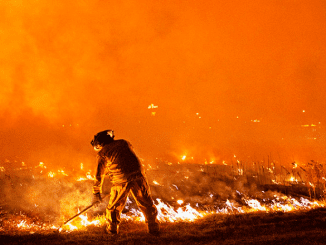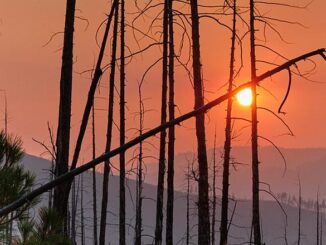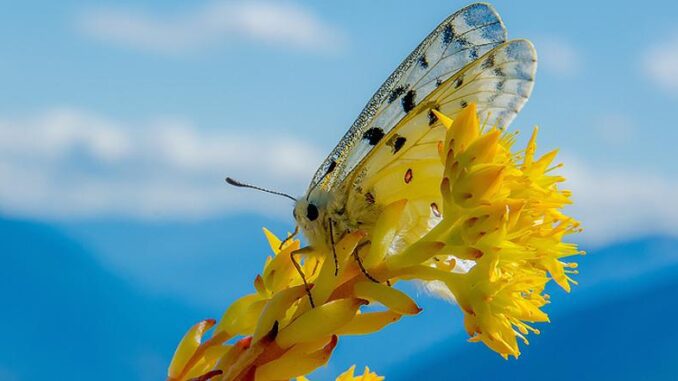
NEW HAVEN, Connecticut, March 31, 2025 (ENS) – Climate change is altering butterfly habitats, turning their species-rich, mountain refuges into traps, finds new research by U.S. and German scientists. They think of it as the butterfly effect – the idea that a small event can have a big, unpredictable influence on the future – in reverse. A large, global series of events is affecting tiny butterflies.
Mountaintops are inhabited by many of the world’s most diverse clusters of butterfly species, but new research shows that climate change could turn those habitats into traps.
For the study, a team co-led by Yale University ecologist Walter Jetz analyzed phylogenetic and geographic range data for more than 12,000 butterfly species worldwide.
Director of the Yale Center for Biodiversity and Global Change and its Max Planck-Yale Center for Biodiversity Movement and Global Change, Jetz arrived at Yale in 2009 and is a professor in the university’s Ecology and Evolutionary Biology Department and in the School of the Environment. He also serves as Scientific Chair of the E.O. Wilson Biodiversity Foundation.
The new study, published in the journal Nature Ecology and Evolution under the title, “Global hotspots of butterfly diversity are threatened in a warming world,” suggests that a lack of comprehensive global data about insects leaves conservationists and policymakers poorly-prepared to reduce biodiversity loss from climate change for many insect species.
The research team was co-led by Stefan Pinkert, an insect scientist at the Philipps University of Marburg, in Germany, and a former postdoctoral associate at Yale.
The scientists found that butterfly diversity is clustered in tropical and subtropical mountains. Two-thirds of butterfly species live in the mountains, which contain 3.5 times more butterfly hotspots than lowlands do.
Yet mountain ecosystems and surrounding areas are being altered by the changing climate. The Yale- Marburg study predicts that 64 percent of the temperature niche space of butterflies in tropical areas will erode by 2070, with the geographically restricted temperature conditions of mountains constantly shrinking.
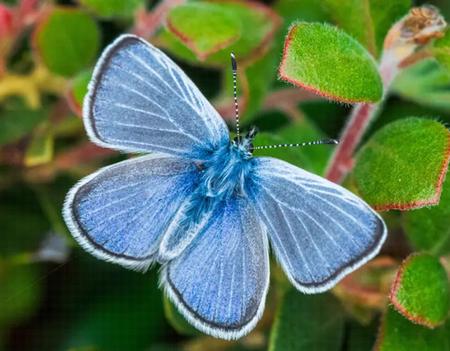
“The diversity, elegance, and sheer beauty of butterflies impassion people worldwide,” said Jetz.
“Co-evolved with host plants, butterflies form an integral part of an ecologically functioning web of life,” he said. “Unfortunately, our first global assessment of butterfly diversity and threats finds that butterflies’ fascinating diversification into higher-elevation environments might now spell their demise, with potentially thousands of species committed to extinction from global warming this century.”
Pinkert explained, “As an entomologist, I am committed to informing the public about the distribution of insect diversity and targeted ways to protect it. Our results are insightful from an ecological point of view but unfortunately also very alarming.”
Current priorities in biodiversity preservation, the researchers observe, are geared to animals and plants, rather than to insects. Until now, a global assessment of the geographic coincidence of diversity, rarity, and climate change threats for an insect system did not exist.
The new assessment reveals that patterns in butterfly diversity differ from those of much better studied groups such as birds, mammals, and amphibians – challenging the relevance of existing conservation priorities, the researchers said.
“This research was made possible by many years of mobilizing various global data and newly developed integrative approaches, all aimed at filling this critical information gap for at least one insect taxon,” Pinkert said.
Jetz said he hoped the new study, and future research enabled by the Map of Life, a global database Jetz directs, that tracks the distribution of known species worldwide, will support conservation managers to include insects in their plans for biodiversity preservation.
“A reduction of carbon emissions, combined with proactive identification and preservation of key butterfly habitats and migratory corridors, will be key to ensuring that much of butterfly diversity survives to benefit future generations,” Jetz said.
Co-authors of the study are Nina Farwig of the University of Marburg and Akito Kawahara of the University of Florida.
The research was supported, in part, by the Alexander von Humboldt Foundation, the Gordon and Betty Moore Foundation, the National Science Foundation, and the E.O. Wilson Biodiversity Foundation.
The Yale-Marburg study’s predictions were confirmed on January 30, 2025, when the Xerces Society for Invertebrate Conservation, a U.S.-based nonprofit, released the results of the 28th annual Western Monarch Butterfly Count, reporting a peak population of 9,119 monarchs this year.
This is the second lowest overwintering population ever recorded since tracking began in 1997.
“The western monarch butterfly is one of the most recognizable species in California, and we are greatly distressed by the results of this year’s Western Monarch Count,” said Randy Widera, director of Programs for the nonprofit California State Parks Foundation. “California State Parks Foundation has worked hard to protect and conserve Monarch groves in state parks. We will continue this work, but we also must see monarchs listed as a Threatened species under the Endangered Species Act.”
The Monarch Count findings, reported in today’s issue of the journal Science, align with an analysis by California State Parks Foundation, which highlights the important role state parks play in monarch conservation. Three of the top four overwintering sites for western monarchs are located in California state parks: the Lighthouse Field State Beach has the most with 1,406 monarchs this year, and coming in second is Natural Bridges State Beach with 1,400 monarchs.
Commenting on the foundation’s analysis, Science editor Bianca Lopez wrote, “Combining data from 35 citizen science programs across the continental US, the authors found declines in overall butterfly abundance over the past 20 years across almost all major regions. Two-thirds of studied species showed declines of more than 10 percent.”
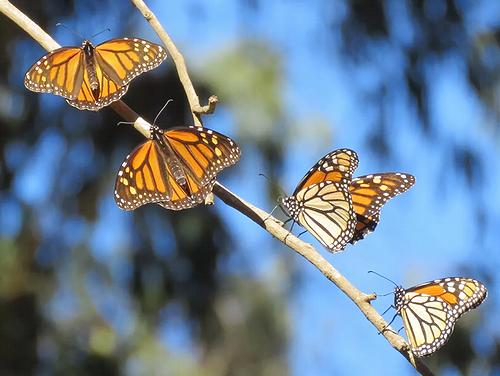
Millions of western monarchs used to return to coastal California every year, but the population has plummeted in recent decades, and fewer than 2,000 butterflies were counted in California in 2020, according to the California State Parks Foundation.
Factors that have contributed to this decline include climate change, habitat loss, pesticides, and disease. The western monarch population had rebounded in the past several years, with almost 233,000 butterflies counted in 2023–2024.
Listing the monarch butterfly as a Threatened species under the U.S. Endangered Species Act is crucial, urges the foundation, as the latest Species Status Assessment predicts a greater than 95 percent chance of extinction for western monarchs by 2080. The proposed Threatened listing emphasizes the protection of overwintering groves – critical sites where monarch butterflies return each year.
Featured image: Alpine butterflies like the Rocky Mountain Apollo (pictured above and on front page) have a rapid life cycle that makes it possible for scientists to see how successive generations are being affected by climate change in mountain ecosystems. (Photo by Zac MacDonald courtesy University of Alberta)


